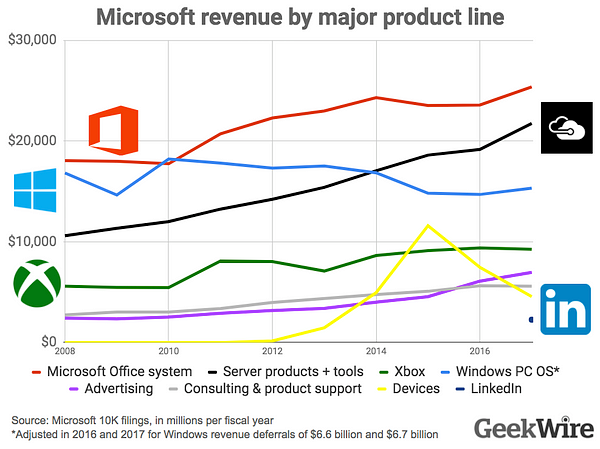 The unprecedented opportunity to leverage the decline of one of the most profitable monopolies in history: Microsoft Office. Under Satya’s leadership, Microsoft’s strategy has shifted away from “Windows everywhere” to an infrastructure and software play of “Microsoft everywhere”. More than anything, this shift is acknowledgement that the days of milking old monopolies are gone and the company must expand beyond Windows and Office to re-frame their offering and innovate again. The reasons Microsoft’s dominant position was so heavily disrupted can be summed up by two simple words: Mobile and Internet. The dynamics of that disruption are well documented, and I could write about that at length, but the focus of this post is to bring attention to the very specific opportunity surrounding the Office products and services.
The unprecedented opportunity to leverage the decline of one of the most profitable monopolies in history: Microsoft Office. Under Satya’s leadership, Microsoft’s strategy has shifted away from “Windows everywhere” to an infrastructure and software play of “Microsoft everywhere”. More than anything, this shift is acknowledgement that the days of milking old monopolies are gone and the company must expand beyond Windows and Office to re-frame their offering and innovate again. The reasons Microsoft’s dominant position was so heavily disrupted can be summed up by two simple words: Mobile and Internet. The dynamics of that disruption are well documented, and I could write about that at length, but the focus of this post is to bring attention to the very specific opportunity surrounding the Office products and services.
Until Satya’s strategy shift, virtually all products and services within Microsoft had one goal: reinforce the Windows monopoly. Office, Windows Phone, Internet Explorer, Visual Studio. They all played a role. If a great product didn’t fit this goal, or threatened it in any way, it got killed (see: Courier). The “Windows first” strategy become increasingly awkward in my final years at the company as Office revenue started to dramatically outgrow Windows.
 Microsoft 10K filing summarised by GeekWire
Microsoft 10K filing summarised by GeekWire
I spent eight years at Microsoft, starting off in a technical role inside the developer division and ending as the chief of staff for the president of what became the company’s largest division, Office. I recall product planning sessions for Office in 2011 where we argued with the Windows teams because countless Office features we intended to build didn’t fit the design and computing goals for Windows 8. The tension between the two divisions demonstrated that the balance of power had shifted away from Windows. Eventually Windows 8 launched and completely flopped in the market. The product was flawed, but that’s not why it failed. Windows has always been flawed, and although this release was particularly bad, I believe it failed because consumers had viable alternative options in 2012 when it became available. Microsoft lost their monopoly on the desktop operating system. They never secured it on the phone and rising tablet market, and it was now disappearing on the desktop.
To their credit, Microsoft pivoted incredibly fast to the cloud, where I believe a long and highly profitable future awaits. On the client side, Apple and Google moved in to take market share from Windows. But, there is still a bigger prize to be won: Office. It may not seem intuitive, as Office 365 revenues are stronger than ever, but I believe that’s because their value proposition resonates so strongly with CIO’s. Companies can now stop worrying about their enterprise infrastructure, and let Microsoft handle it. Everyone wins in this equation, except for the most important person: the information worker. These are the millions of employees forced to use the software handed down to them from their IT departments. These employees are stuck using clunky client software designed for work in a very different era.
For a lucky few organisations, their CIO’s have already ripped the bandaid off and moved to Google’s G Suite. But, what is G Suite? It’s a faster version of Office in the cloud. That’s it. But with that simple distinction, Google built this business from $0 to $3bn in less than a decade. Impressive as that is, they have barely scratched the surface of big enterprise. That just goes to show how much latent demand and opportunity there is in the productivity market.
 Jean Jullien via Dribble
Jean Jullien via Dribble
Don’t get me wrong, Word, Excel, PowerPoint, and Outlook are good products. But, they are to employee productivity what the most advanced copper-wire analog phone is to telephony: a useful tool for a handful of individuals in a world that’s otherwise moved on. If you stick with my analogy for a minute, imagine the “mobile phone of productivity” and you’ll get a sense of the opportunity. There will simultaneously be a significant shift away from legacy productivity software alongside a dramatic market expansion.
A good friend of mine moved from Microsoft’s Office team to Google, to help build their productivity business (and, interestingly, is now doing the same thing at Facebook). He summarised Google’s strategy in the early days as focussing on the 20% of features that 80% of users actually need, instead of the thousands of features in Office that were rarely used. There’s an important lesson there for other’s that want to challenge Microsoft (and Google). The traditional advice when building software for the enterprise is to create a new solution that is 10x better than existing solution. That’s simply not possible if you’re going after Office. The product and technical barriers are high, but the biggest barrier is Microsoft’s single enterprise vendor model. This is perhaps the only reason Office continues to thrive. What is possible is to dramatically improve life for a set of information workers underserved by existing solutions, and use that advantage as a wedge into a larger offering, slowly, over time. I believe the single enterprise vendor model will erode on it’s own over time, and so I wouldn’t recommend any challenger large or small, try to replicate that. Massive winners can be formed doing one or two things exceptionally well for a large number of information workers.
We’ll see more and more of these innovative bespoke solutions pop up, rethinking various layers of the productivity stack. While this list is varied in terms of growth, they are all small relative to the opportunity.
I hear about new solutions all the time, and would love to add to this list if there’s a great startup out there that’s not yet included.
*Thanks to Dev Bala, Prateek Srivastava
No comments:
Post a Comment